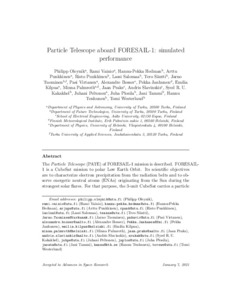Particle telescope aboard FORESAIL-1: Simulated performance
Oleynik Philipp; Vainio Rami; Hedman Hannu-Pekka; Punkkinen Arttu; Punkkinen Risto; Salomaa Lassi; Säntti Tero; Tuominen Jarno; Virtanen Pasi; Bosser Alexandre; Janhunen Pekka; Kilpua Emilia; Palmroth Minna; Praks Jaan; Slavinskis Andris; Kakakhel Syed RU; Peltonen Juhani; Plosila Juha; Tammi Jani; Tenhunen Hannu; Westerlund Tomi
Particle telescope aboard FORESAIL-1: Simulated performance
Oleynik Philipp
Vainio Rami
Hedman Hannu-Pekka
Punkkinen Arttu
Punkkinen Risto
Salomaa Lassi
Säntti Tero
Tuominen Jarno
Virtanen Pasi
Bosser Alexandre
Janhunen Pekka
Kilpua Emilia
Palmroth Minna
Praks Jaan
Slavinskis Andris
Kakakhel Syed RU
Peltonen Juhani
Plosila Juha
Tammi Jani
Tenhunen Hannu
Westerlund Tomi
Elsevier Ltd
Julkaisun pysyvä osoite on:
https://urn.fi/URN:NBN:fi-fe2021042822073
https://urn.fi/URN:NBN:fi-fe2021042822073
Tiivistelmä
The Particle Telescope (PATE) of FORESAIL-1 mission is described. FORESAIL-1 is a CubeSat mission to polar Low Earth Orbit. Its scientific objectives are to characterize electron precipitation from the radiation belts and to observe energetic neutral atoms (ENAs) originating from the Sun during the strongest solar flares. For that purpose, the 3-unit CubeSat carries a particle telescope that measures energetic electrons in the nominal energy range of 80–800 keV in seven energy channels and energetic protons at 0.3–10 MeV in ten channels. In addition, particles penetrating the whole telescope at higher energies will be measured in three channels: one >800 keV electron channel, two integral proton channels at >10 MeV energies. The instrument contains two telescopes at right angles to each other, one measuring along the spin axis of the spacecraft and one perpendicular to it. During a spin period (nominally 15 s), the rotating telescope will, thus, deliver angular distributions of protons and electrons, at 11.25-degree clock-angle resolution, which enables one to accurately determine the pitch-angle distribution and separate the trapped and precipitating particles. During the last part of the mission, the rotation axis will be accurately pointed toward the Sun, enabling the measurement of the energetic hydrogen from that direction. Using the geomagnetic field as a filter and comparing the rates observed by the two telescopes, the instrument can observe the solar ENA flux for events similar to the only one so far observed in December 2006. We present the Geant4-simulated energy and angular response functions of the telescope and assess its sensitivity showing that they are adequate to address the scientific objectives of the mission.
Kokoelmat
- Rinnakkaistallenteet [27094]
